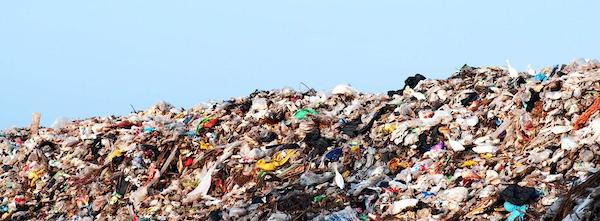Articles and News
Editorial: Jewelry Is Key To The Fashion/Environment Discussion | November 20, 2019 (0 comments)

New York, NY—If you want to make a positive impact on the environment, get off Instagram. Or at least, don’t let it rule your wardrobe choices. And wear more fine jewelry.
That’s not as far a stretch as it seems. In an Instagram world, where not only celebrities but even regular consumers try not to be seen in the same outfit twice, the need for constant newness is one of the main drivers behind fashion’s disposability. According to data published in The New York Times, three-fifths of all clothing ends up in incinerators or landfills within a year of being produced. Image at left: Swedish retailer H&M, one of the world's leading and best-known fast-fashion brands, offers a clothing recycling program.)
At the recent Initiatives in Art And Culture Fashion & Design Conference, a discussion between fashion stylist Andrew Gelwicks and Decades retailer Cameron Silver addressed exactly this issue. They pointed out that in social media culture, wearing something more than once has become a major faux pas. Kate Middleton can get away with it, but most women can’t. But if consumers would invest in their closets, buy high quality clothing meant to last, and be willing to wear it over again many times—even on camera—the positive impact on the environment would be significant.
The fashion industry is, without question, responsible for a tremendous amount of global pollution. But though widely believed that it is the second-most polluting industry in the world, there is no hard data to back up the assertion. As these excellent articles in the late Racked and The New York Times point out, its purported ranking as #2 comes from circular feedback repeated so often and so convincingly that it is accepted as fact. (The Environmental Protection Agency says the top five contributors to carbon emissions are energy, transportation, industry, the residential/commercial/institutional sector, and agriculture.)
Second-worst or not, the fashion industry is a major polluter. In addition to the three fifths of all clothing going to incinerators or landfills within a year of being produced, theTimes article also says about 20-25% of chemical compounds produced globally are used in the textile finishing industry. Those chemicals need to go somewhere.

Three-fifths of all clothing purchased goes to incinerators or landfills within a year of being produced, says The New York Times. Image: Recycling Textile Management via rtmrecycling.com.
The fashion/textile/footwear industry also produces more than 8% of global greenhouse gases, says the Times. By contrast, the independent study released earlier this year by the Diamond Producers Association shows the diamond industry is far cleaner.
Diamond mining doesn’t require chemicals to extract the stones. It’s messy, but not highly toxic. More than 99% of the waste produced in diamond mining is just rock—crushed, sifted, washed, then put back in place when the mine closes—a much easier mess to clean up than toxic waste. And 83% of the water used in diamond mining is recycled.
Sure, there’s some pollution when you factor in exhaust from the gas- or diesel-powered heavy equipment used in mining, or the pollution generated to build those machines in the first place, but that’s pretty much the extent of it because the actual extraction of diamonds from the earth doesn’t require chemicals.
Related: Independent Report Finds Lab-Grown Diamonds May Use More Energy, Not Less, Than Mined
Gold, on the other hand, is a different story, and one that jewelers need to keep on their radar screens. Read more about that here and here. Still, there are enough responsible gold miners and recycled options to avoid dirty gold.
Related: Documentary Shows Gold Overtakes Cocaine As Colombia’s Top Criminal Export
I believe the entire climate-change discussion needs to be reframed on a global level. This goes way beyond jewelry, fashion, or even the fossil fuel industries. I see two separate issues here: climate change and toxic pollution. Both are problems, but they need to be addressed individually. Just addressing climate change will not necessarily reduce toxic pollution.
Because it's become such a politicized issue, climate change discussions tend to make people dig in and find data—reliable or not—to back up their pre-existing beliefs. But I’ll bet even the most die-hard climate change deniers still don’t want cyanide in their drinking water or mercury in their kids' tuna sandwiches. That is likely where the common ground is, and where we can start to make some real progress in addressing environmental issues before it’s too late.
Back to fashion, jewelry, and the eco-conscious closet. At the IAC conference, Gelwicks and Silver emphasized the importance of social media in promoting sustainability. While the British royal family and prominent figures like Michelle Obama might lead by example and wear the same garments over, the media punishes other women for it as often as it praises them. For instance, if two celebrities borrow the same sample, they’re likely to end up in a “who wore it better?” article. Gelwicks suggests that instead of asking who wore it better, the media should reframe the discussion as an example of multiple ways to style the same piece. Voilà—a positive, eco-conscious message, vs. negativity and shaming.
For jewelers on a local level, try reframing some of your marketing. Instead of waiting until you’re forced to take a reactive stance after a media exposé or a lab-grown diamond company’s marketing plants questions in consumers’ minds, position fine jewelry as the original investment dressing. Emphasize how pieces can be worn over and over, not only reducing their original purchase price to pennies per day, but that it can be restyled and recycled without environmental damage. Discuss options for recycled or fair-mined metals or estate jewelry. Point consumers to the stories of good that come from our industry, such as the stories on diamondsdogood.com.
And, finally, show how, with a change in jewelry, consumers can completely change the look of any outfit—reducing the need to buy more clothes and create more toxic waste.







